What Is the Connection? Understanding Shared Micromobility Links to Rail Public Transit Systems in Major California Cities
Abstract
1. Introduction
2. Literature Review
3. Methodological Overview
3.1. Data Description and Preprocessing
- San Francisco: Caltrain, Bay Area Rapid Transit (BART) District, San Francisco Municipal Railway (Muni);
- Sacramento: Sacramento Regional Transit District (SACRT);
- Los Angeles: Metrolink, LA Metro Rail;
- San Jose: Valley Transportation Authority (VTA).
3.2. Categorizing Rail Transit Connection Trips
3.2.1. Trip Origin/Destination Distance from a Nearby Rail Transit Station
- Egress trips are likely to start within this circle;
- Access trips are likely to terminate within this circle;
- A trip is likely connecting to the closer station if its origin or destination falls within multiple circles.
3.2.2. Identifying Substitution Trips for Rail Public Transit
3.2.3. Identifying Trips Occurring during Transit Schedules
4. Results and Discussion
4.1. Characteristics of All Trips
4.2. Sensitivity Analysis of Trips Connecting to Public Transit
4.3. Percentage of Shared Micromobility Trips Connecting to Public Transit
4.4. Spatial Distribution of Identified Connecting Trips
4.5. Characteristics of Public Transit Connecting Trips
5. Conclusions
Author Contributions
Funding
Institutional Review Board Statement
Informed Consent Statement
Data Availability Statement
Acknowledgments
Conflicts of Interest
References
- Moon, C.; Sharpin, A.B.; De La Lanza, I.; Khan, A.; Re, L.L.; Maassen, A. The Evolution of Bike Sharing: 10 Questions on the Emergence of New Technologies, Opportunities, and Risks; World Resources Institute: Washington, DC, USA, 2019. [Google Scholar]
- Shaheen, S.; Guzman, S.; Zhang, H. Bikesharing in Europe, the Americas, and Asia: Past, Present, and Future. J. Transp. Res. Board 2010, 2143, 159–167. [Google Scholar] [CrossRef]
- Joyride. A Look Back at the History of Mobility Share. Joyride. Available online: https://joyride.city/history-of-mobility-share-html/ (accessed on 8 July 2021).
- National Association of City Transportation Officials [NACTO]. Shared Micromobility in the U.S.: 2018; National Association of City Transportation Officials: New York, NY, USA, 2018; Available online: https://nacto.org/shared-micromobility-2018 (accessed on 8 July 2021).
- NACTO. Shared Micromobility in the U.S.: 2019; National Association of City Transportation Officials: New York, NY, USA, 2019; Available online: https://nacto.org/shared-micromobility-2019 (accessed on 5 July 2021).
- NACTO. Bike Share in the US: 2010–2016; National Association of City Transportation Officials: New York, NY, USA, 2017; Available online: https://nacto.org/bike-share-statistics-2016/ (accessed on 5 July 2021).
- Kager, R.; Bertolini, L.; Te Brömmelstroet, M. Characterisation of and Reflections on the Synergy of Bicycles and Public Transport. Transp. Res. Part A Policy Pract. 2016, 85, 208–219. [Google Scholar] [CrossRef]
- Zuo, T.; Wei, H.; Chen, N.; Zhang, C. First-and-Last Mile Solution via Bicycling to Improving Transit Accessibility and Advancing Transportation Equity. Cities 2020, 99, 102614. [Google Scholar] [CrossRef]
- Martin, E.W.; Shaheen, S.A. Evaluating Public Transit Modal Shift Dynamics in Response to Bikesharing: A Tale of Two U.S. Cities. J. Transp. Geogr. 2014, 41, 315–324. [Google Scholar] [CrossRef]
- Shaheen, S.A.; Zhang, H.; Martin, E.; Guzman, S. China’s Hangzhou Public Bicycle: Understanding Early Adoption and Behavioral Response to Bikesharing. Transp. Res. Rec. 2011, 2247, 33–41. [Google Scholar] [CrossRef]
- Tempelaar, D.; Rienties, B.; Nguyen, Q. Subjective Data, Objective Data and the Role of Bias in Predictive Modelling: Lessons from a Dispositional Learning Analytics Application. PLoS ONE 2020, 15, e0233977. [Google Scholar] [CrossRef]
- Tobias, M.S.G.; Maia, M.L.A.; Pinto, I.M.D. Challenges for Integrating Bicycles and Public Transport in Brazilian Metropolitan Regions. In Proceedings of the 18th International Conference on Urban Transport and the Environment, A Coruna, Spain, 15–17 May 2012; pp. 229–239. [Google Scholar] [CrossRef]
- Oeschger, G.; Carroll, P.; Caulfield, B. Micromobility and Public Transport Integration: The Current State of Knowledge. Transp. Res. Part D Transp. Environ. 2020, 89, 102628. [Google Scholar] [CrossRef]
- Ma, X.; Ji, Y.; Jin, Y.; Wang, J.; He, M. Modeling the Factors Influencing the Activity Spaces of Bikeshare around Metro Stations: A Spatial Regression Model. Sustainability 2018, 10, 3949. [Google Scholar] [CrossRef]
- Ma, X.; Ji, Y.; Yang, M.; Jin, Y.; Tan, X. Understanding Bikeshare Mode as a Feeder to Metro by Isolating Metro-Bikeshare Transfers from Smart Card Data. Transp. Policy 2018, 71, 57–69. [Google Scholar] [CrossRef]
- Ma, T.; Liu, C.; Erdoğan, S. Bicycle Sharing and Public Transit: Does Capital Bikeshare Affect Metrorail Ridership in Washington, D.C.? Transp. Res. Rec. 2015, 2534, 1–9. [Google Scholar] [CrossRef]
- Griffin, G.P.; Sener, I.N. Planning for Bike Share Connectivity to Rail Transit. J. Public Trans. 2016, 19, 1–22. [Google Scholar] [CrossRef] [PubMed]
- Martens, K. Promoting Bike-and-Ride: The Dutch Experience. Transp. Res. Part A Policy Pract. 2007, 41, 326–338. [Google Scholar] [CrossRef]
- Gu, T.; Kim, I.; Currie, G. Measuring Immediate Impacts of a New Mass Transit System on an Existing Bike-Share System in China. Transp. Res. Part A Policy Pract. 2019, 124, 20–39. [Google Scholar] [CrossRef]
- Guo, Y.; He, S.Y. Built Environment Effects on the Integration of Dockless Bike-Sharing and the Metro. Transp. Res. Part D Transp. Environ. 2020, 83, 102335. [Google Scholar] [CrossRef]
- Guo, Y.; Yang, L.; Lu, Y.; Zhao, R. Dockless Bike-Sharing as a Feeder Mode of Metro Commute? The Role of the Feeder-Related Built Environment: Analytical Framework and Empirical Evidence. Sustain. Cities Soc. 2021, 65, 102594. [Google Scholar] [CrossRef]
- Ma, X.; Jin, Y.; He, M. Measuring Bikeshare Access/Egress Transferring Distance and Catchment Area around Metro Stations from Smartcard Data. Information 2018, 9, 289. [Google Scholar] [CrossRef]
- Ji, Y.; Ma, X.; Yang, M.; Jin, Y.; Gao, L. Exploring Spatially Varying Influences on Metro-Bikeshare Transfer: A Geographically Weighted Poisson Regression Approach. Sustainability 2018, 10, 1526. [Google Scholar] [CrossRef]
- Miramontes, M.; Pfertner, M.; Rayaprolu, H.S.; Schreiner, M.; Wulfhorst, G. Impacts of a Multimodal Mobility Service on Travel Behavior and Preferences: User Insights from Munich’s First Mobility Station. Transportation 2017, 44, 1325–1342. [Google Scholar] [CrossRef]
- Hamidi, Z.; Camporeale, R.; Caggiani, L. Inequalities in Access to Bike-and-Ride Opportunities: Findings for the City of Malmö. Transp. Res. Part A Policy Pract. 2019, 130, 673–688. [Google Scholar] [CrossRef]
- Tarpin-Pitre, L.; Morency, C. Typology of Bikeshare Users Combining Bikeshare and Transit. Transp. Res. Rec. 2020, 2674, 475–483. [Google Scholar] [CrossRef]
- Pritchard, J.P.; Stępniak, M.; Geurs, K.T. 5-Equity Analysis of Dynamic Bike-and-Ride Accessibility in the Netherlands. In Measuring Transport Equity; Lucas, K., Martens, K., Di Ciommo, F., Dupont-Kieffer, A., Eds.; Elsevier: Amsterdam, The Netherlands, 2019; pp. 73–83. [Google Scholar] [CrossRef]
- Kong, H.; Jin, S.T.; Sui, D.Z. Deciphering the Relationship between Bikesharing and Public Transit: Modal Substitution, Integration, and Complementation. Transp. Res. Part D Transp. Environ. 2020, 85, 102392. [Google Scholar] [CrossRef]
- Fearnley, N.; Johnsson, E.; Berge, S.H. Patterns of E-Scooter Use in Combination with Public Transport. Findings 2020, 13707. [Google Scholar] [CrossRef]
- Azimi, G.; Rahimi, A.; Lee, M.; Jin, X. Mode Choice Behavior for Access and Egress Connection to Transit Services. Int. J. Transp. Sci. Technol. 2021, 10, 136–155. [Google Scholar] [CrossRef]
- Esztergár-Kiss, D.; Lopez Lizarraga, J.C. Exploring User Requirements and Service Features of E-Micromobility in Five European Cities. Case Stud. Transp. Policy 2021, 9, 1531–1541. [Google Scholar] [CrossRef]
- North American Bikeshare Association [NABSA]. GBFS & Open Data. North American Bikeshare Association. Available online: https://nabsa.net/resources/gbfs/ (accessed on 3 October 2020).
- GTFS. General Transit Feed Specification. Available online: https://gtfs.org/ (accessed on 3 October 2020).
- Road Bike Rider. What’s the Average Speed of a Beginner Cyclist? Road Bike Rider Cycling Site. Available online: https://www.roadbikerider.com/whats-the-average-speed-of-a-beginner-cyclist/ (accessed on 24 November 2020).
- Gonzales, R. A Bicyclist Hit-and-Run on a Bike Path Is Now a Crime, as New Laws Come into Play. San Bernardino Sun. Available online: https://www.sgvtribune.com/2018/12/31/a-bicyclist-hit-and-run-on-a-bike-path-is-now-a-crime-as-new-laws-come-into-play/ (accessed on 12 July 2021).
- Martens, K. The Bicycle as a Feedering Mode: Experiences from Three European Countries. Transp. Res. Part D Transp. Environ. 2004, 9, 281–294. [Google Scholar] [CrossRef]
- State of California. About COVID-19 Restrictions. Available online: https://covid19.ca.gov/stay-home-except-for-essential-needs/ (accessed on 7 December 2020).
- Sacramento Regional Transit. Final Network Integration Plan. 2021. Available online: http://www.sacrt.com/aboutrt/documents/SacRT-Network-Plan-Approved_20211025.pdf (accessed on 26 October 2023).
- Zipper, D. Why Don’t Transit Agencies Do Bikeshare? Bloomberg.com. 15 April 2021. Available online: https://www.bloomberg.com/news/articles/2021-04-15/transit-agencies-can-make-bikeshare-work-better (accessed on 7 July 2021).
- VTA. VTA’s BART Silicon Valley Extension Program. Available online: https://www.vta.org/projects/bart-sv (accessed on 2 April 2021).
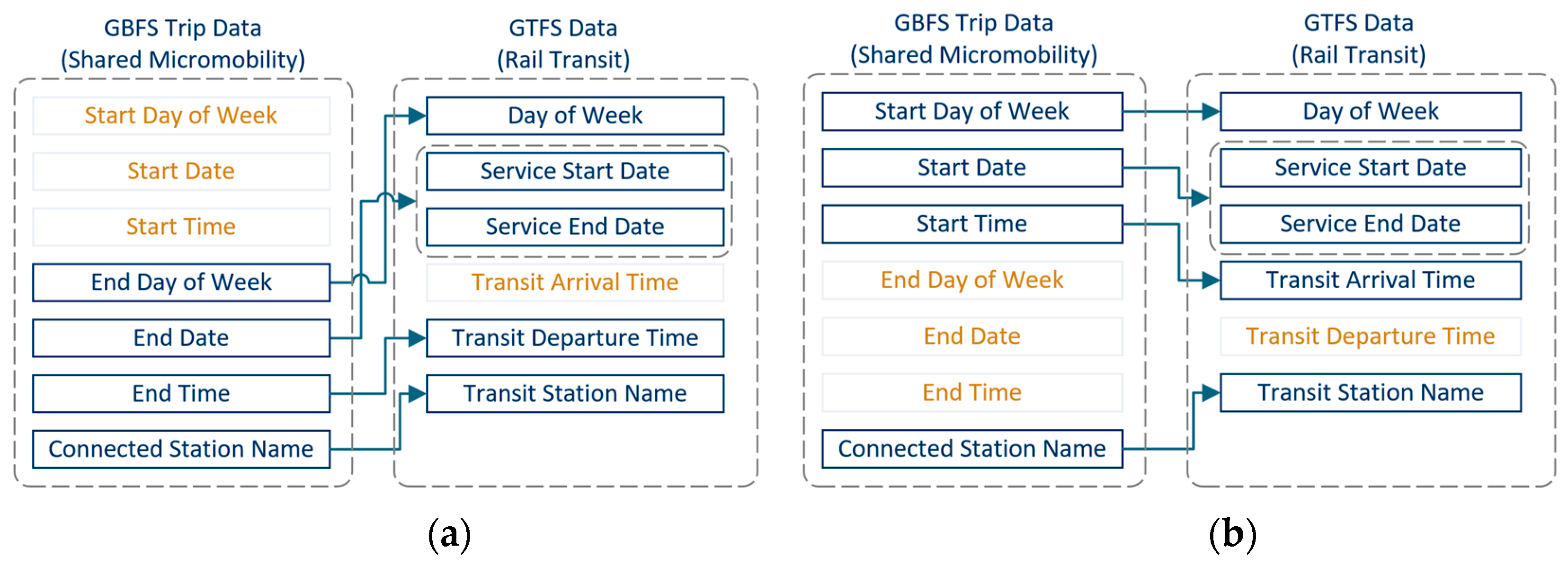
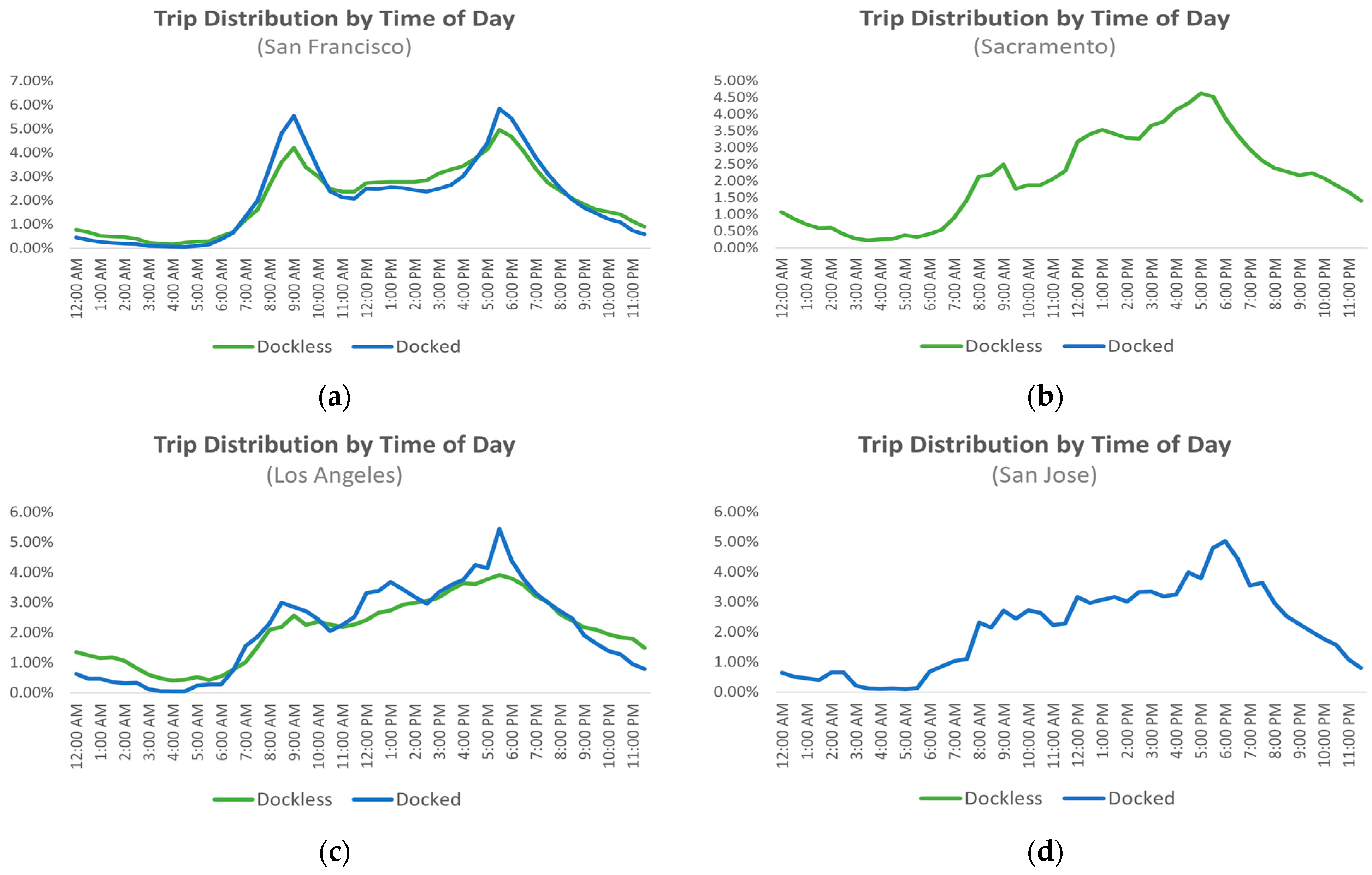

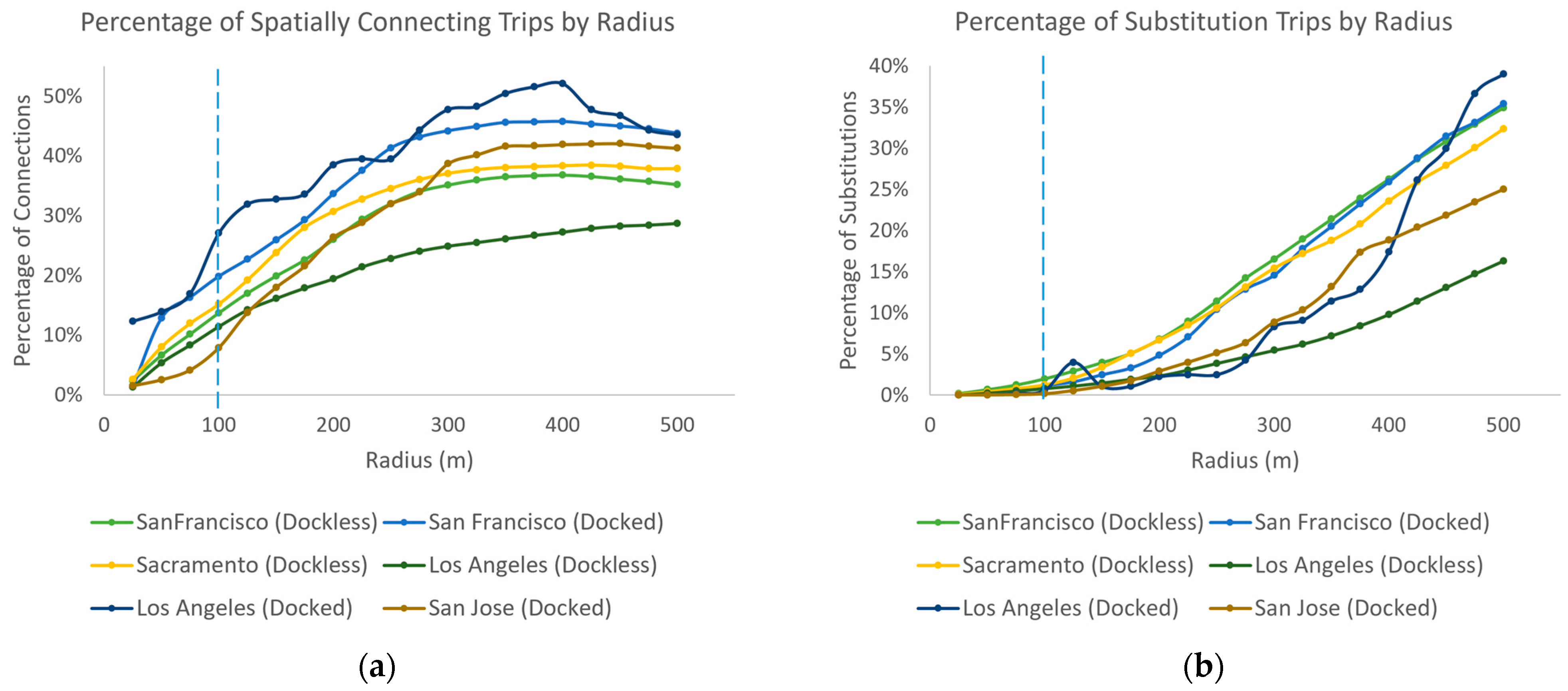

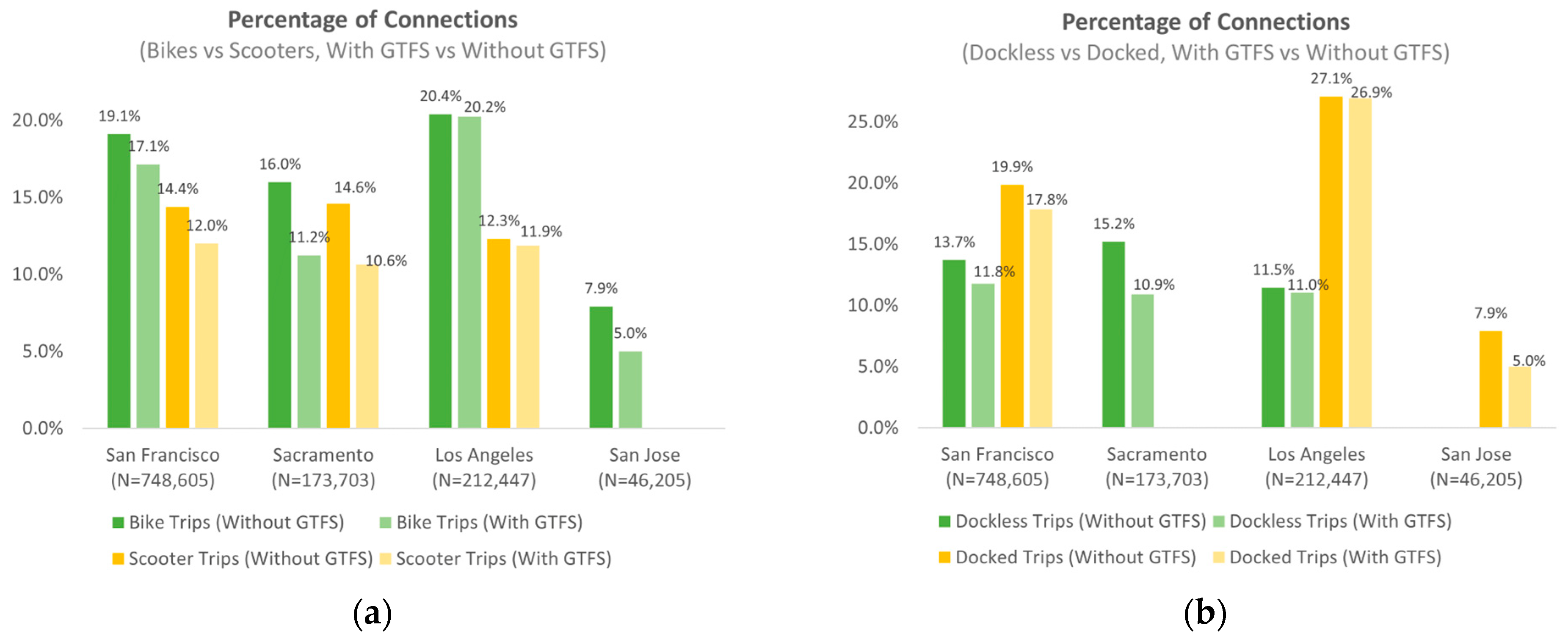
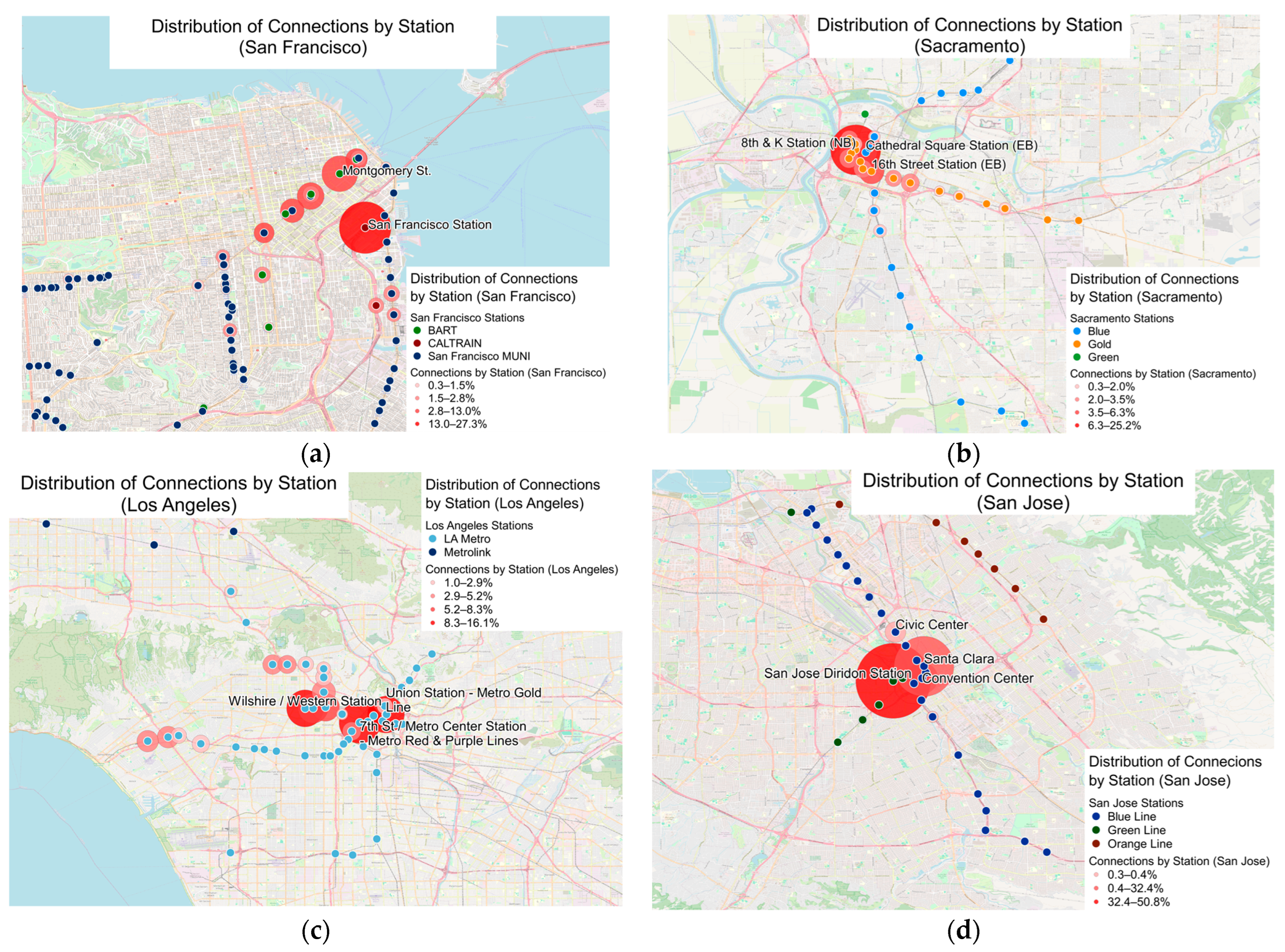
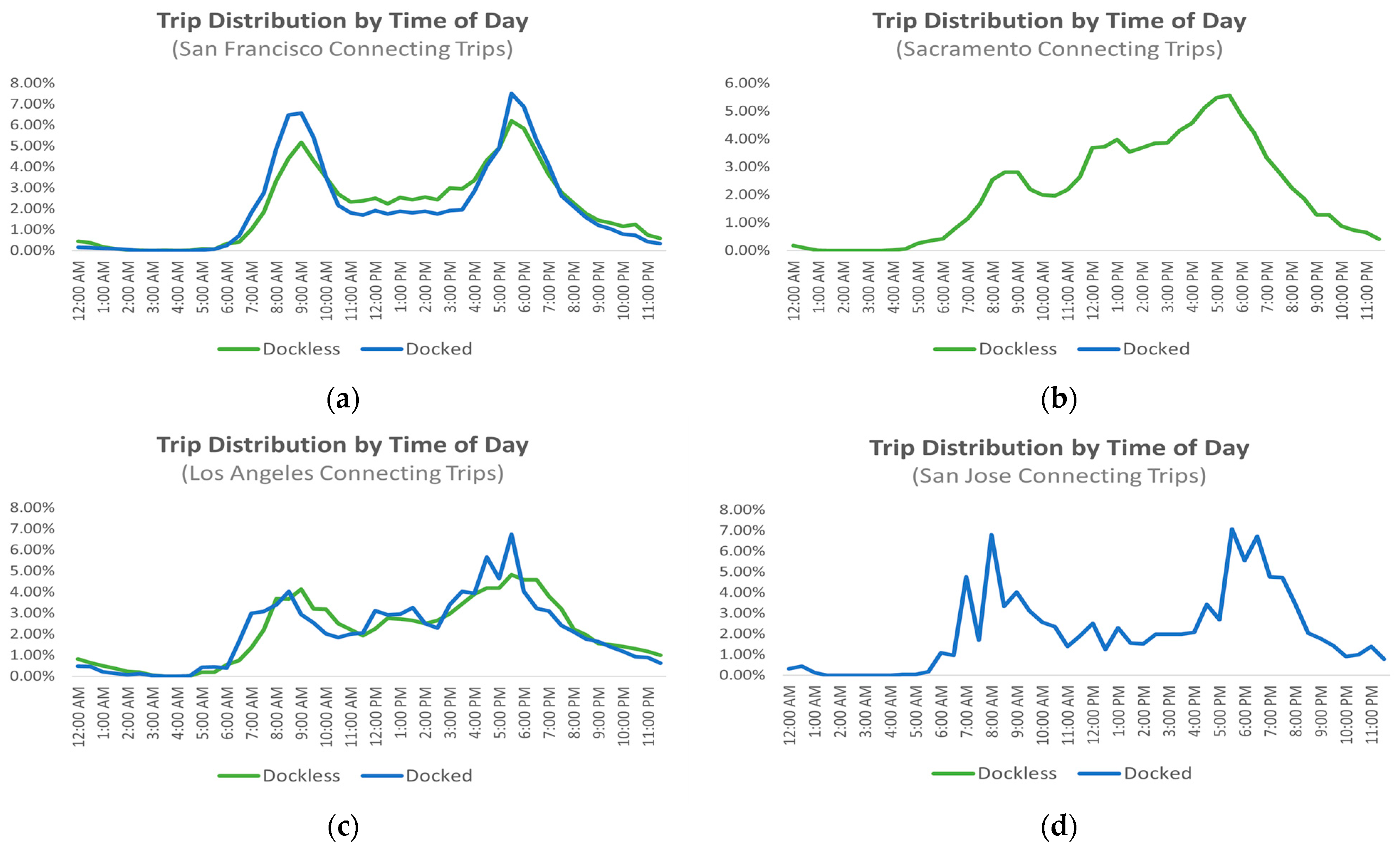

| San Francisco | Sacramento | Los Angeles | San Jose | ||
|---|---|---|---|---|---|
| Trips by System | Dockless scooter sharing | 78,770 | 97,332 | 145,449 | -- |
| Dockless E-bikesharing | 74,311 | 76,371 | 20,732 | -- | |
| Docked bikesharing | 595,524 | -- | 46,266 | 46,205 | |
| Total Trips | 748,605 | 173,703 | 212,447 | 46,205 | |
| First Trip | 1 January 2020 | 6 January 2020 | 3 October 2019 | 1 January 2020 | |
| Last Trip | 29 February 2020 | 28 February 2020 | 29 February 2020 | 29 February 2020 | |
| City | Number of Substitutions | Percentage of Trips | Station 1 | Station 2 | Number of Trips | Distance (m) |
|---|---|---|---|---|---|---|
| San Francisco | 9940 | 1.33% | San Francisco | Montgomery | 1174 | 1931 |
| San Francisco | Powell Street | 481 | 1609 | |||
| San Francisco | Embarcadero | 389 | 3219 | |||
| San Francisco | Van Ness | 334 | 3541 | |||
| Powell Street | Montgomery | 189 | 1127 | |||
| Sacramento | 2168 | 1.25% | 8th & K | Cathedral Square | 169 | 483 |
| 8th & K | 13th Street | 54 | 1287 | |||
| 8th & K | 23rd Street | 48 | 2736 | |||
| 8th & K | 7th & I/County Center | 47 | 483 | |||
| 8th & K | 16th Street | 43 | 1770 | |||
| Los Angeles | 1619 | 0.76% | Wilshire/Western | Wilshire/Normandie | 113 | 805 |
| 7th Street/Metro Center | Pico Station | 74 | 1287 | |||
| Chinatown | Union Station | 70 | 1127 | |||
| Hollywood/Highland | Hollywood/Vine | 34 | 1287 | |||
| 7th Street/Metro Center | Union Station | 28 | 4989 | |||
| San Jose | 75 | 0.16% | Diridon Station | Race Station | 15 | 2414 |
| Santa Clara | Convention Center | 7 | 805 | |||
| Diridon Station | Japantown/Ayer | 4 | 2575 | |||
| Santa Clara | Japantown/Ayer | 6 | 1127 | |||
| Diridon Station | Santa Clara | 3 | 1448 |
| Statistics | Two-Sample Test (Sample Size = 1000) | |||
|---|---|---|---|---|
| Mean | Median | D-Value | p-Value | |
| Distance (m) | ||||
| All Trips | 1890 | 1552 | 0.082 | 0.013 (*) |
| Connecting Trips | 2012 | 1672 | ||
| Duration (min) | ||||
| All Trips | 11.37 | 9.02 | 0.053 | 0.190 (-) |
| Connecting Trips | 11.13 | 9.02 | ||
| Velocity (km/h) | ||||
| All Trips | 10.91 | 11.37 | 0.095 | 0.006 (**) |
| Connecting Trips | 11.78 | 12.03 | ||
Disclaimer/Publisher’s Note: The statements, opinions and data contained in all publications are solely those of the individual author(s) and contributor(s) and not of MDPI and/or the editor(s). MDPI and/or the editor(s) disclaim responsibility for any injury to people or property resulting from any ideas, methods, instructions or products referred to in the content. |
© 2024 by the authors. Licensee MDPI, Basel, Switzerland. This article is an open access article distributed under the terms and conditions of the Creative Commons Attribution (CC BY) license (https://creativecommons.org/licenses/by/4.0/).
Share and Cite
Ju, M.; Martin, E.; Shaheen, S. What Is the Connection? Understanding Shared Micromobility Links to Rail Public Transit Systems in Major California Cities. Sustainability 2024, 16, 555. https://doi.org/10.3390/su16020555
Ju M, Martin E, Shaheen S. What Is the Connection? Understanding Shared Micromobility Links to Rail Public Transit Systems in Major California Cities. Sustainability. 2024; 16(2):555. https://doi.org/10.3390/su16020555
Chicago/Turabian StyleJu, Mengying, Elliot Martin, and Susan Shaheen. 2024. "What Is the Connection? Understanding Shared Micromobility Links to Rail Public Transit Systems in Major California Cities" Sustainability 16, no. 2: 555. https://doi.org/10.3390/su16020555
APA StyleJu, M., Martin, E., & Shaheen, S. (2024). What Is the Connection? Understanding Shared Micromobility Links to Rail Public Transit Systems in Major California Cities. Sustainability, 16(2), 555. https://doi.org/10.3390/su16020555







